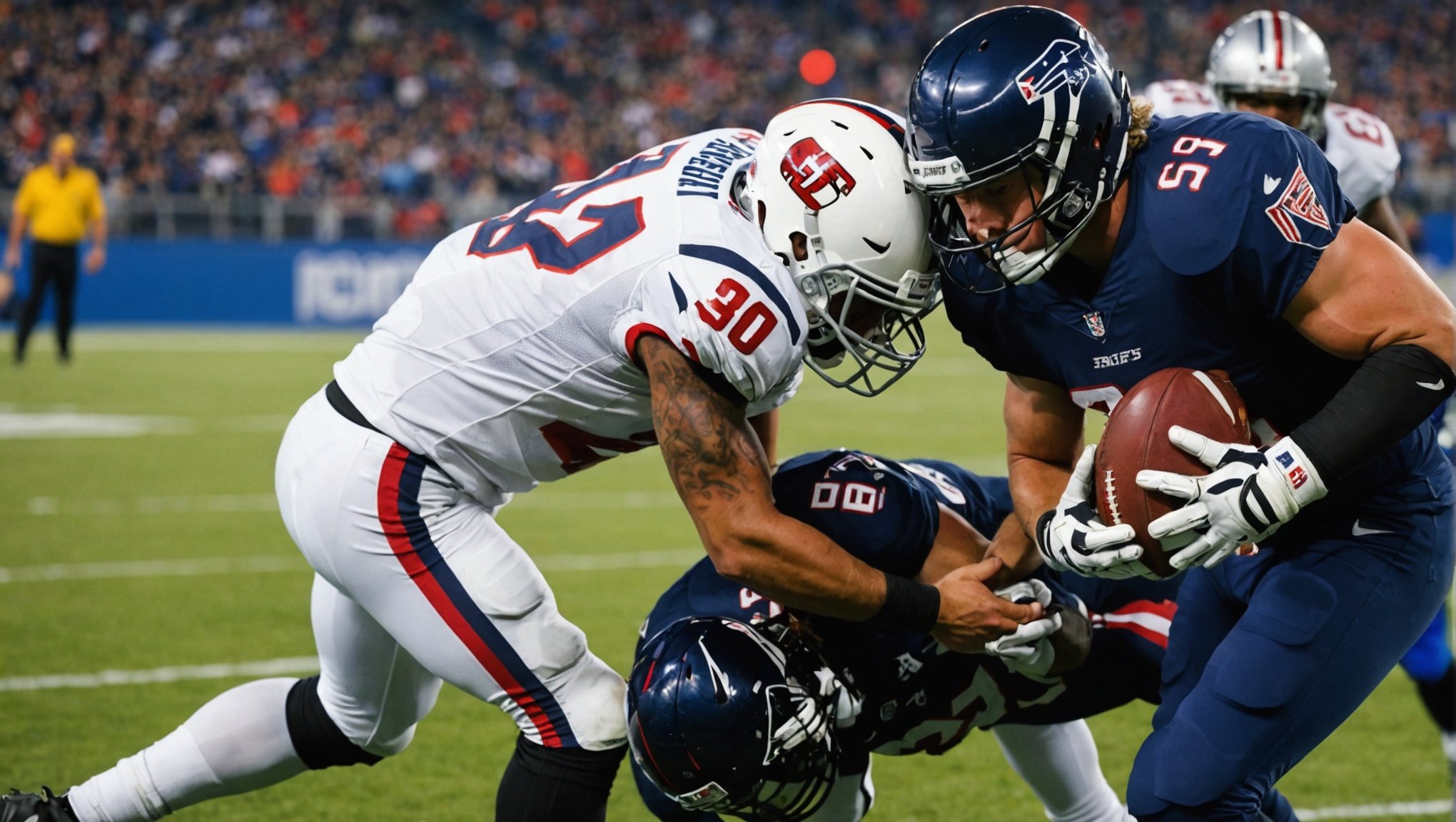Understanding Concussion Risks in American Football
In American football, an increased concussion awareness has shed light on the concerning prevalence of these serious injuries. Concussions occur frequently due to the high-impact nature of the sport, often resulting from direct blows to the head or violent shaking of the head and body. This concern elevates the need for stringent injury prevention measures.
The mechanics of concussions involve the brain moving rapidly within the skull, potentially causing damage to brain cells. This can lead to various long-term effects, such as cognitive difficulties, memory loss, and emotional disturbances, making player safety a priority. It is crucial, therefore, to implement comprehensive safety protocols and protective gear to minimize risks.
This might interest you : Maximizing Tactical Communication: Key Strategies for Team Handball Athletes
Recognizing concussion symptoms early is essential in preventing further injury and long-term consequences. Symptoms can include headaches, confusion, dizziness, and sensitivity to light. Concussion awareness programs can play a vital role in educating players, coaches, and medical staff about these indicators, ensuring prompt and appropriate response.
Enhancing injury prevention strategies in American football is not just about adding more protective equipment, but also about fostering a culture that values player safety and understands the serious implications of concussions. This approach can help safeguard the long-term health and wellbeing of athletes.
In parallel : Unlocking Power: Essential Grip Strength Techniques for Judo Athletes to Enhance Performance
Proper Tackling Techniques
Understanding the correct tackling methods is key to reducing injuries in sports. Safe play requires athletes to adopt these methods meticulously. A major component of injury reduction, especially in contact sports like rugby and American football, involves specific techniques that emphasise safety without compromising performance.
Effective tackling begins with proper form and technique. Players should keep their heads up, aiming to make contact with the shoulder rather than the head, thus minimising the risk of concussions. Footwork, body alignment, and posture also play roles in executing a safe tackle. Coaches are essential in teaching and reinforcing these methods during training, ensuring every player understands and applies safe techniques.
Impact on Concussion Rates
Case studies have shown that proper tackling significantly reduces concussion rates. For example, certain schools have implemented strict tackling protocols, resulting in a noticeable decline in head injuries. The data supports the direct correlation between educated sporting staff and lower injuries.
Coaching and consistent training are vital for instilling these techniques. Effective coaching provides athletes with the skills and knowledge necessary to protect themselves and others during play. This focus on education and technique not only fosters a safer sporting environment but also enhances overall performance.
Helmet Safety and Technology
When it comes to headgear standards, helmets are vital for injury protection. Ensuring your helmet meets established safety standards is essential. Certifications like the European EN 1078 or the American CPSC enhance reliability. A helmet marked with these standards indicates it has passed rigorous safety tests.
Technological advancements have reshaped helmet innovation over recent years. For instance, MIPS (Multi-directional Impact Protection System) technology is a notable development that offers effective rotational force protection. This innovation is found in many modern helmets and can significantly reduce the risk of concussion during an impact.
When choosing a helmet, selecting the right fit and design for each age group is crucial. For children, helmets with simple fastening systems and vibrant colours may encourage consistent use. Teenagers might prefer more stylish designs, possibly integrated with Bluetooth connectivity for a tech-savvy edge. Adult helmets, meanwhile, might focus on advanced safety features and ventilation to ensure comfort during extended wear.
To summarise:
- Know the standards – look for EN 1078 or CPSC certification.
- Consider the innovation – MIPS is a popular safety feature.
- Age matters – choose designs suited to specific age needs.
Safety first!
Comprehensive Training Programs
Comprehensive training regimens play a pivotal role in reducing concussion risks. Key components include tailored injury prevention programs aimed at reinforcing cognitive and physical resilience. Strength and conditioning are critical, as they help in building stronger neck and shoulder muscles, which may mitigate the impact during collisions. These programs are meticulously designed to encompass exercises that enhance balance and coordination, crucial elements in maintaining player safety.
Effective skill development within training regimens ensures athletes are equipped not only physically but also mentally. Cognitive exercises could incorporate memory tasks and spatial awareness drills, allowing players to anticipate and effectively respond to intense game scenarios. Such structured regimens lead to heightened awareness, reducing potentially hazardous plays.
Some successful teams have adopted innovative training approaches, showcasing exemplary results in injury prevention. For instance, implementing sensor technology has enabled coaches to monitor impacts during practice, allowing adjustments in training regimens to target specific weaknesses. A notable example is Team A, whose adoption of holistic injury prevention programs has led to a significant drop in concussion rates. These programs focus on education, proper techniques, and continuous evaluation, underscoring the importance of adaptability and comprehensive skill development in sports safety.
Education and Awareness for Coaches and Players
Understanding and addressing concussion risks in sports is a growing priority. Effective knowledge dissemination among coaches and players is crucial. Implementing educational strategies can significantly enhance awareness. Workshops and training sessions focused on concussion-related topics can equip coaches and players with essential information. This includes recognising concussion symptoms and understanding the appropriate response measures.
Sports organizations play a vital role by launching awareness campaigns aimed at improving the knowledge base regarding concussions. These campaigns can demystify misconceptions and reinforce the importance of addressing head injuries with seriousness. Visual and digital media, as well as seminars, are effective in reaching a broad audience, fostering a culture of safety.
Concussion protocols are indispensable for structured guidance. They outline crucial steps, such as initial assessment procedures and gradual reintroduction to play. Clear and accessible return-to-play guidelines ensure that players recover thoroughly before resuming activities, minimizing the risk of further injury. Regularly updating these protocols is essential as research evolves.
By integrating these strategies, sports entities can create an environment where the health and safety of players are prioritized. This approach not only strengthens the trust in sports institutions but also enhances the overall standard of player welfare.
The Role of Parents and Guardians
Active parental involvement is crucial in ensuring youth sports are safe and supportive. Parents can advocate for safer sports practices by engaging directly with coaches and sports organisations. This engagement includes asking about safety protocols, understanding equipment use, and ensuring that proper training is provided to players and staff.
Monitoring player health and safety is another critical aspect. Parents should pay close attention to any signs of injury or discomfort. Frequent communication with children about how they feel physically and emotionally helps in catching potential issues early. Encouraging children to speak out about any pain or concerns reinforces a culture of safety within sports.
To empower themselves, parents should take advantage of available resources aimed at education and advocacy. These might include workshops provided by schools or clubs, online materials from reputable sports safety organisations, or even meetings with healthcare professionals familiar with youth athletes’ needs.
By engaging in these practices, parents not only help in creating a safer sports environment but also establish a supportive dialogue with their children. This involvement ensures sports remain a positive influence, fostering healthy athletic and emotional development.
Resources and Support from Sports Organizations
Understanding the role of sports organizations in concussion management is crucial. These organizations ensure player safety by providing comprehensive guidelines on concussion prevention and care. For instance, international and national sports bodies work relentlessly to produce resources that educate athletes, coaches, and medical staff. In addition, these guidelines offer insights into recognizing concussion symptoms and managing recovery effectively.
Establishing robust support networks is another pivotal responsibility of these organizations. They aim to bridge gaps between different sports bodies, fostering collaboration to enhance safety measures. Such networks facilitate sharing of best practices, enable joint concussion prevention initiatives, and ensure consistent implementation of guidelines across disciplines.
Furthermore, sports organizations are at the forefront of fostering and funding ongoing studies and research into concussion prevention. Recognizing the evolving nature of sports and the complexities of injuries, they regularly update resources based on the latest scientific findings. This commitment to support networks and leveraging research helps establish a proactive approach to athlete health and safety, ensuring sports remain a safe and enjoyable pursuit for everyone involved.






